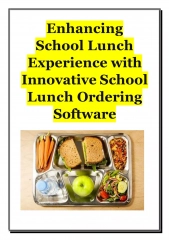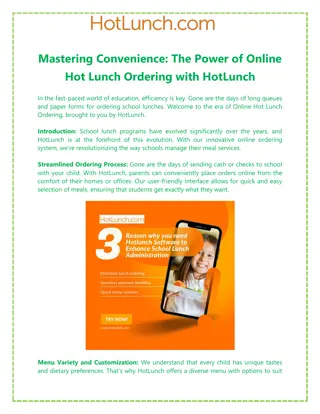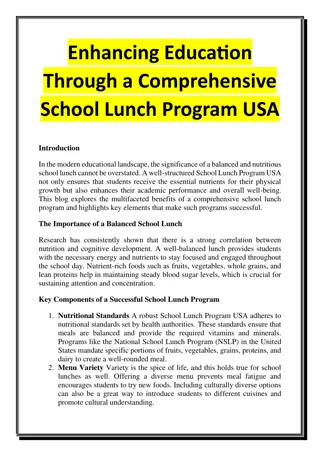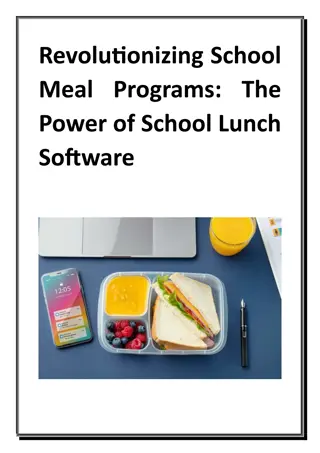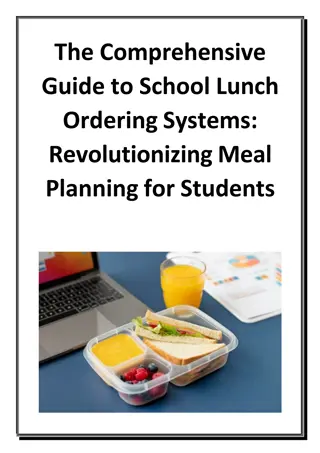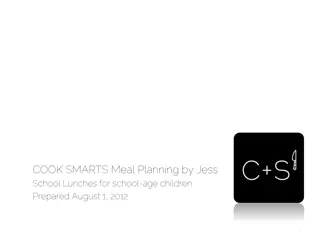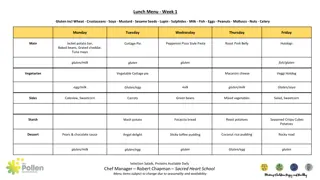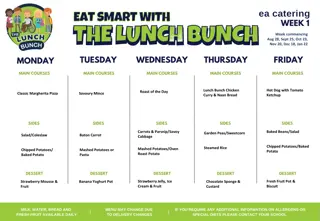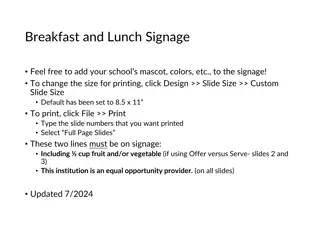
Empowering Students with Healthy School Lunch Choices
Offering a variety of school lunch choices is about more than just satisfying hunger; itu2019s an opportunity to educate, empower, and nurture the next generation. By prioritizing diversity, balance, and innovation in school lunch programs, we can c
Uploaded on | 0 Views
Download Presentation

Please find below an Image/Link to download the presentation.
The content on the website is provided AS IS for your information and personal use only. It may not be sold, licensed, or shared on other websites without obtaining consent from the author. Download presentation by click this link. If you encounter any issues during the download, it is possible that the publisher has removed the file from their server.
E N D
Presentation Transcript
Empowering Students with Healthy School Lunch Choices
Introduction The significance of nutritious meals in the academic and overall growth of students cannot be overstated. School lunch programs have evolved beyond merely serving food; they now play a pivotal role in shaping students' health and eating habits. Offering diverse and balanced school lunch choices not only ensures better nutrition but also empowers students to make informed dietary decisions. The Importance of School Lunch Choices School lunches contribute significantly to a student's daily nutrient intake. By providing a variety of options, schools can: Promote Healthy Eating Habits: Offering balanced meals that include fruits, vegetables, proteins, and whole grains encourages students to adopt healthier eating patterns. Accommodate Dietary Needs: Catering to different dietary restrictions and preferences, such as vegetarian, gluten-free, or nut-free meals, ensures inclusivity. Foster Autonomy: Allowing students to choose their meals helps them take responsibility for their dietary decisions, instilling independence and accountability. Key Features of a Good School Lunch Program 1.Diversity A variety of meals caters to diverse tastes and dietary requirements, reducing food waste and increasing satisfaction. Rotating menus keep the offerings fresh and appealing to students. in Menu Options 2.Nutritional Schools should prioritize meals that provide essential nutrients to support cognitive and physical development. Balanced meals enhance concentration, energy levels, and overall academic performance. Balance 3.Customization Programs that allow students or parents to customize meals help meet individual preferences, ensuring a greater likelihood of consumption and enjoyment. and Flexibility
4.Digital Many schools now use software solutions for lunch ordering, enabling parents and students to pre-select meals. These platforms streamline operations and reduce errors, making meal management more efficient. Tools for Convenience Benefits of Offering a Variety of School Lunch Choices Encourages Exploration: Exposing students to new foods helps expand their palates and encourages them to try nutritious options. Reduces Food Waste: When students have a say in their meals, they are less likely to discard food, minimizing waste. Improves Academic Outcomes: Studies have shown that well-nourished students perform better academically and are more engaged in class. Supports Local Farmers: Incorporating locally sourced ingredients into menus promotes sustainable practices and supports community farmers. Challenges in Implementing Diverse Lunch Choices 1.Budget Constraints: Schools often face financial limitations that can restrict menu diversity. 2.Logistical Issues: Managing diverse meal options can be challenging without proper systems in place. 3.Nutritional Education: Ensuring that students understand the importance of choosing nutritious options requires consistent effort. Solutions for Better School Lunch Programs Invest in Technology: Digital platforms simplify the process of menu planning, ordering, and delivery, making diverse options feasible. Collaborate with Nutritionists: Schools can work with dietitians to design balanced and appealing menus. Seek Community Support: Engaging with local farmers and organizations can help source fresh and cost-effective ingredients. Educate Students: Providing workshops or materials on nutrition encourages informed choices among students. Conclusion
Offering a variety of school lunch choices is about more than just satisfying hunger; it s an opportunity to educate, empower, and nurture the next generation. By prioritizing diversity, balance, and innovation in school lunch programs, we can create an environment where students thrive both academically and physically. Schools, parents, and communities must work together to ensure that every child has access to nutritious, appealing, and customizable meals.


